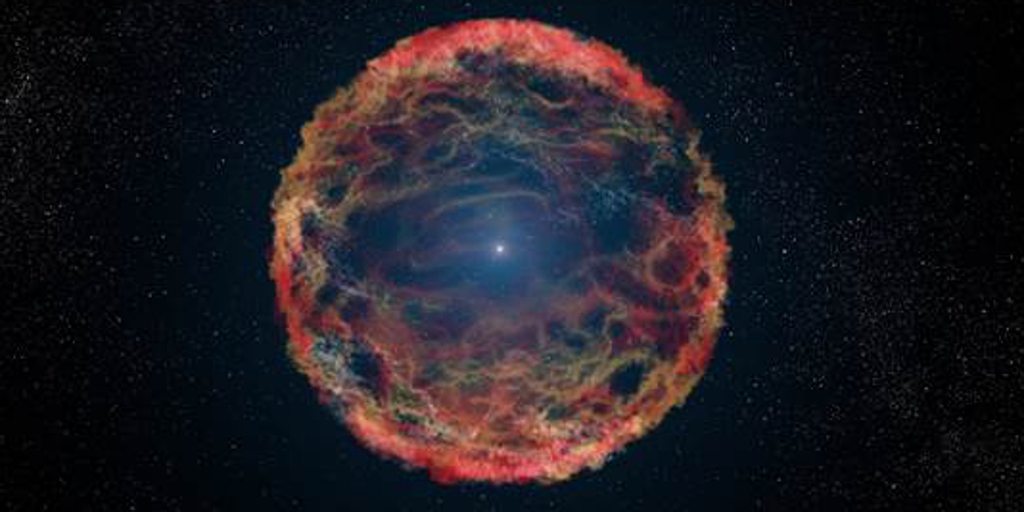Note an international team with the participation of the Supreme Council for Scientific Research (CSIC) The early stages of a supernova. The shot, which combines three different moments within a few hours of the stellar explosion, corresponds to a star that was 500 times larger than the sun and exploded 11,000 million years ago, when the universe was still primitive. This image, captured by the NASA and European Space Agency (ESA) Hubble Space Telescope, was published in the journal. ‘nature tempered’.
This is the first time that a supernova in its early stages has been observed with such accuracy at such a distance, moreover, it corresponds to a stellar explosion at the beginning of the history of the universe. Both findings could help the scientific community learn more about the formation of stars and galaxies in the early universe.
“It’s very rare to detect a supernova at a very early stage, because that stage is so short,” explains Wenley Chen, first author of the research paper and researcher in the School of Physics and Astronomy at the University of Minnesota. “They last from a few hours to a few days, and can easily go unnoticed even for early detection. At the same exposure, we were able to see a series of images, like the multiple phases of a supernova.”
The Hubble Telescope captured in a single image three unique moments of a supernova explosion through different phases, which reached Earth at the same time. This image was achieved thanks to a phenomenon called gravity lensWhen a group of galaxies, thousands of times more massive than our own, amplifies the light produced by distant objects aligned behind the cluster. It works like a lens, magnifying the light that reaches us from the supernova, making it visible to a space telescope.
In this way, the galaxy cluster Abell 370 behaves as if it were a lens, magnifying the light of the distant supernova, which was located behind the cluster. Magnified images by this lens took three different paths through the cluster, due to length differences in the paths taken by light from the supernova, the slowing of time, and the curvature of space by gravity predicted by Albert Einstein.
An image taken by the Hubble Telescope showing the three stages of a supernova explosion behind the ‘Abell 370’ galaxy cluster.
Because light takes different times to travel through these three paths, the Hubble image shows three moments of the explosion in one image. Of these three moments, one of them corresponds only a few hours after the explosion,” explains Jose Maria Diego, researcher at the Institute of Physics in Cantabria (IFCA, CSIC-UC).
In addition, the telescope captured changes in the temperature of the supernova, which were observed with a difference in color. The bluer the button, the hotter the supernova, and when its light cools, it becomes redder. “You see different colors in the three images,” says Patrick Kelly, study leader and professor in the University of Minnesota’s School of Physics and Astronomy. “In the core of a massive star there is a shock, it gets hot, and then you see it cools. It is probably one of the most amazing things I have ever seen.”
giant star
Observations show that the red giant star was 500 times larger than the Sun. This is the first time that the research team has been able to measure the dimensions of a dying star in the early universe. To achieve this, they relied on machine learning algorithms to measure the star’s brightness and cooling rate.
Now, take advantage of launching a space telescope James Webb NASA, the team plans to begin observing supernovae at a greater distance and create a catalog of supernovae that will help understand whether stars that existed billions of years ago are different from those in the universe we know today.

“Beer enthusiast. Subtly charming alcohol junkie. Wannabe internet buff. Typical pop culture lover.”

:quality(85)/cloudfront-us-east-1.images.arcpublishing.com/infobae/MRVSEWSMUDE76ALGNSVPFHPFJU.jpg)
:quality(85)/cloudfront-us-east-1.images.arcpublishing.com/infobae/OP6XMZ4VNBCYHC7YF6RXLFROJM.jpg)
:quality(85)/cloudfront-us-east-1.images.arcpublishing.com/infobae/UTVBELC67FCTNLNEX5VBXRPTNE.jpg)



More Stories
Helldivers II players achieve something they haven't achieved since the game's launch
How to easily unsubscribe from Wise, the fintech entity for international payments
Days can be up to 25 hours long